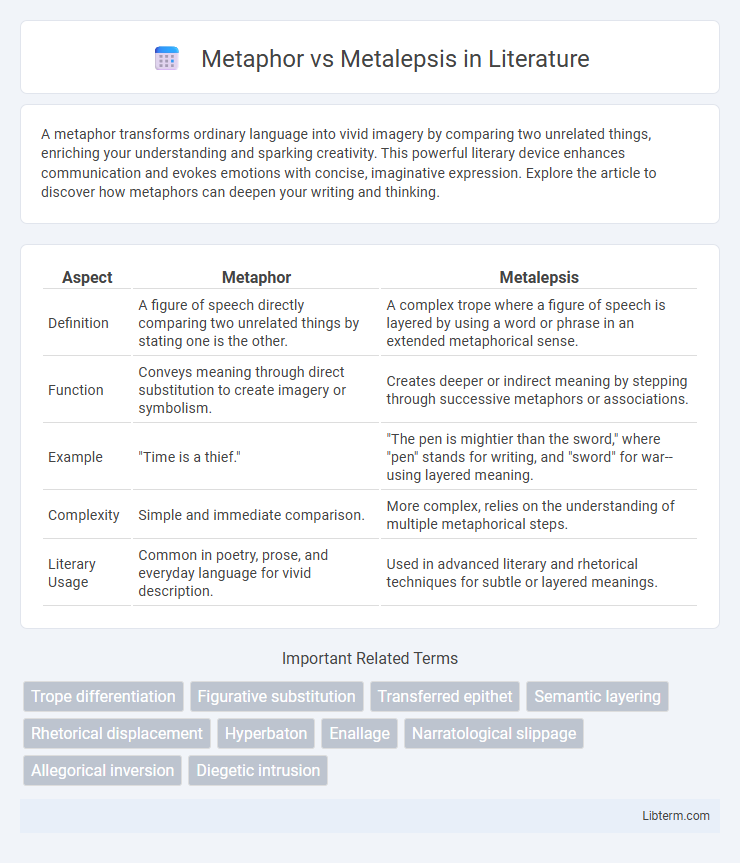A metaphor transforms ordinary language into vivid imagery by comparing two unrelated things, enriching your understanding and sparking creativity. This powerful literary device enhances communication and evokes emotions with concise, imaginative expression. Explore the article to discover how metaphors can deepen your writing and thinking.
Table of Comparison
| Aspect | Metaphor | Metalepsis |
|---|---|---|
| Definition | A figure of speech directly comparing two unrelated things by stating one is the other. | A complex trope where a figure of speech is layered by using a word or phrase in an extended metaphorical sense. |
| Function | Conveys meaning through direct substitution to create imagery or symbolism. | Creates deeper or indirect meaning by stepping through successive metaphors or associations. |
| Example | "Time is a thief." | "The pen is mightier than the sword," where "pen" stands for writing, and "sword" for war--using layered meaning. |
| Complexity | Simple and immediate comparison. | More complex, relies on the understanding of multiple metaphorical steps. |
| Literary Usage | Common in poetry, prose, and everyday language for vivid description. | Used in advanced literary and rhetorical techniques for subtle or layered meanings. |
Introduction to Metaphor and Metalepsis
Metaphor is a fundamental figure of speech that involves describing one thing in terms of another to highlight similarities and deepen understanding. Metalepsis extends metaphor by creating a more complex, layered reference where one concept is indirectly connected to another through a chain of associations. Understanding the distinction between metaphor and metalepsis is essential in literary studies, as it enhances comprehension of nuanced language and interpretive creativity.
Defining Metaphor: Meaning and Usage
Metaphor is a figure of speech that directly compares two unrelated subjects by stating one is the other, creating symbolic meaning to enhance understanding or evoke imagery. It functions by transferring qualities from one entity to another, facilitating deeper interpretation beyond literal language. Metaphors are widely used in literature, communication, and cognitive processing to illustrate complex concepts through familiar terms.
Understanding Metalepsis: Beyond Metaphor
Metalepsis extends metaphor by creating a layered narrative relationship where one figurative expression indirectly references another, often requiring deeper cognitive engagement to interpret. Unlike metaphor, which directly compares two concepts, metalepsis relies on an implied logical or causal chain, linking distant semantic fields in literature and rhetoric. Understanding metalepsis enhances comprehension of complex texts by revealing hidden connections and amplifying thematic depth beyond straightforward metaphorical usage.
Key Differences Between Metaphor and Metalepsis
Metaphor involves a direct comparison between two unrelated concepts to highlight shared qualities, enhancing understanding through symbolic representation. Metalepsis operates by referencing an intermediate step or a chain of metaphors, creating a layered, often more complex connection that relies on cultural or contextual knowledge. The key difference lies in metaphor's straightforward analogy versus metalepsis's indirect, multi-stage reference structure.
Historical Origins of Metaphor and Metalepsis
Metaphor originates from ancient Greek rhetoric, where it was used as a figure of speech that transfers meaning by substituting one word or phrase for another to create symbolic connections. Metalepsis, emerging later in classical literary theory, extends metaphor by using a chain of metaphoric associations to convey deeper or more complex meanings, often relying on cultural and contextual understanding. Both figures reflect evolving linguistic creativity, with metaphor established by Aristotle and metalepsis gaining prominence through medieval and Renaissance literary criticism.
Examples of Metaphor in Literature
Metaphor in literature often involves direct comparisons, such as Shakespeare's "All the world's a stage," symbolizing life as a theatrical performance. In contrast, metalepsis creates complex layers of meaning by referencing multiple narrative levels or concepts simultaneously, as seen in works like Jorge Luis Borges' "The Garden of Forking Paths," where reality and fiction intertwine. Examples of metaphor enrich texts by providing vivid imagery, emotional depth, and symbolic resonance, enhancing readers' engagement with the themes and characters.
Examples of Metalepsis in Literary Works
Metalepsis, a sophisticated rhetorical device, presents a layered reference where one metaphorical expression is used to convey another, creating a deeper connection in literature. Examples include James Joyce's *Ulysses*, where metalepsis blurs reality and narrative levels, and in Edgar Allan Poe's *The Raven*, where the phrase "Nevermore" extends beyond a bird's cry to embody eternal loss. This technique enhances thematic complexity by interlinking symbols and narrative elements across different contexts.
Functions and Effects in Narrative Structure
Metaphor functions as a figurative device that creates symbolic meanings by linking disparate concepts, enriching narrative depth and thematic resonance. Metalepsis operates as a transgressive figure of speech that breaks narrative boundaries, enabling shifts between fictional levels and enhancing reader engagement through metafictional effects. Both devices shape narrative structure by modulating perspective and interpretive layers, influencing how stories convey meaning and challenge reality.
Challenges in Identifying Metaphor vs Metalepsis
Distinguishing metaphor from metalepsis presents challenges due to their intertwined figurative structures and layered meanings. Metaphor involves direct symbolic substitution, while metalepsis operates through complex chains of reference, often requiring deeper contextual analysis to unravel. The ambiguity in conventional language use further complicates identifying the precise boundary between these two rhetorical devices.
The Importance of Figurative Language in Communication
Figurative language enhances communication by conveying complex ideas and emotions through vivid imagery and symbolic representation. Metaphor directly compares two unrelated concepts, enriching meaning, while metalepsis creates layered associations by substituting one term through a chain of references, intensifying interpretative depth. Mastery of these devices improves persuasiveness and engagement in both literary and everyday communication.
Metaphor Infographic

 libterm.com
libterm.com